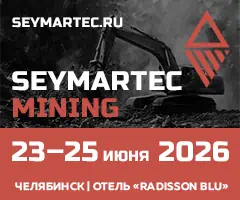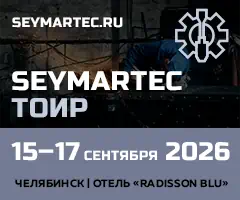Modeling of the rock mass deformations effect on deep metro main line tunnels
 S.A. Zhukov1, M.A. Bubnov2, M.S. Naumov3
S.A. Zhukov1, M.A. Bubnov2, M.S. Naumov3
Mining Institute Kola Science Centre of the Russian Academy of Sciences, Apatity, Russian Federation
Russian Mining Industry №5S / 2024 p.190-196
Abstract: The article discusses the effects of soil mass movement on deep metro main line tunnels. The study is based on the data obtained as part of a field survey of a tunnel section that was exposed to a non-routine event. Displacements of the soil mass surrounding the tunnel during its operation may occur due to disturbance of the groundwater mode caused by abundant water inflow into the tunnel. Solution cavities, especially those filled with water, can also cause deformation of the tunnels during operation, resulting in water inflow into the tunnel. If these cavities are filled with loose sediments, this can also cause significant local loads on the tunnel lining. A number of numerical experiments were carried out to assess the possibility of horizontal displacements of the tunnels, which involved modelling of a 25 m long section of the soil mass enclosing the tunnel. The first stage involved modelling of the soil shrinkage due to progressive shield tunnelling, while the second stage simulated the horizontal displacement front. Dependences of the lining displacement on the distance to the displacement front of the soil mass have been established. Numerical experiments showed that the main geological processes that could lead to deformation of the tunnels occurred at a distance of more than 20 m from the edge of one of the tunnels.
Keywords: metro, main line tunnel, rock mass displacement, soil mass, numerical modeling
For citation: Zhukov S.A., Bubnov M.A., Naumov M.S. Modeling of the rock mass deformations effect on deep metro main line tunnels. Russian Mining Industry. 2024;(5S):190–196. (In Russ.) https://doi.org/10.30686/1609-9192-2024-5S-190-196
Article info
Received: 27.08.2024
Revised: 23.10.2024
Accepted: 26.10.2024
Information about the authors
Sergey A. Zhukov – General Director, Mosinzhproekt JSC, Moscow, Russian Federation; https://orcid.org/0009-0007-6492-6696; e-mail: This email address is being protected from spambots. You need JavaScript enabled to view it.
Mikhail A. Bubnov – Cand. Sci. (Eng.), Associate Professor, Advanced engineering school, Mendeleev Russian University of Chemical Technology, Moscow, Russian Federation; https://orcid.org/0009-0006-5041-8597
Maxim S. Naumov – Lead Engineer of the Department, Moscow Automobile and Road Construction State Technical University, Moscow, Russian Federation; https://orcid.org/0009-0000-1148-1530
References
1. Дуванский А.В. Разработка методики учета тектонических нагрузок при расчете тоннелей глубокого заложения. Строительство и техногенная безопасность. 2013;(47):56–61. Duvansky A.V. Development of a methodology to account for tectonic loads in calculation of deep tunnels. Construction and Industrial Safety. 2013;(47):56–61. (In Russ.)
2. Гуськов И.А., Пестрякова Е.А., Харитонов С.С., Титов Е.Ю. Методы оценки осадок при проходке тоннелей с использованием тоннелепроходческих механизированных комплексов. Транспортные сооружения. 2019;6(3). https://doi.org/10.15862/18SATS319 Guskov I.A., Pestryakova E.A., Kharitonov S.S., Titov E.Yu. Methods for estimating sediment during tunneling using a mechanized tunneling. Russian Journal of Transport Engineering. 2019;6(3). (In Russ.) https://doi.org/10.15862/18SATS319
3. Куликова Е.Ю. Выработка управленческих решений в сфере безопасности подземного строительства. Горный информационно-аналитический бюллетень. 2014;(1):79–82. Kulikova E.Yu. Making of administrative decisions in the field of safety of underground building. Mining Informational and Analytical Bulletin. 2014;(1):79–82. (In Russ.)
4. Алымов В.Т., Крапчатов В.П., Тарасова Н.П. Анализ техногенного риска. М.: Интеграция; 1999. 160 с.
5. Бурков В.Н., Грацианский Е.В., Дзюбко С.И., Щепкин А.В. Модели и механизмы управления безопасностью. М.: СИНТЕГ; 2001. 153 с.
6. Зиновьева О.М., Кузнецов Д.С., Меркулова А.М., Смирнова Н.А. Цифровизация систем управления промышленной безопасностью в горном деле. Горный информационно-аналитический бюллетень. 2021;(2-1):113–123. https://doi.org/10.25018/0236-1493-2021-21-0-113-123 Zinovieva O.M., Kuznetsov D.S., Merkulova A.M., Smirnova N.A. Digitalization of industrial safety management systems in mining. Mining Informational and Analytical Bulletin. 2021;(2-1):113–123. (In Russ.) https://doi.org/10.25018/0236-14932021-21-0-113-123
7. Потапова Е.В. Типология сооружений метрополитена для задач классификации геотехнических рисков. Горные науки и технологии. 2021;6(1):52–60. https://doi.org/10.17073/2500-0632-2021-1-52-60 Potapova E.V. Typology of metro structures for the tasks of geotechnical risk classification. Mining Science and Technology (Russia). 2021;6(1):52–60. (In Russ.) https://doi.org/10.17073/2500-0632-2021-1-52-60
8. Kulikova E.Yu., Balovtsev S.V. Risk control system for the construction of urban underground structures. IOP Conference Series: Materials Science and Engineering. 2020;962:042020. https://doi.org/10.1088/1757-899X/962/4/042020
9. Кауфман Л.Л., Лысиков Б.А. Геотехнические риски в подземном строительстве (обзор зарубежного опыта) [под общ. ред. Л.Л. Кауфмана]. Донецк: Норд-Пресс; 2009. 362 c.
10. Гарбер В.А. Нештатные ситуации в подземных транспортных сооружениях. Подземные горизонты. 2018;(16):20–25. Garber V.A. Non-routine events in underground transport structures. Underground Horizons. 2018;(16):20–25. (In Russ.)
11. Sousa R.L. Risk analysis for tunneling projects: Thesis (Ph. D.). Massachusetts Institute of Technology, Dept. of Civil and Environmental Engineering; 2010. Available at: http://hdl.handle.net/1721.1/58282 (accessed: 13.08.2024).
12. Чунюк Д.Ю. Особенности классификации и составляющие геотехнического риска в строительстве. Промышленное и гражданское строительство. 2013;(9):42–44. Chunyuk D.Yu. Features of classification and components of geotechnical risk in construction. Industrial and Civil Engineering. 2013;(9):42–44. (In Russ.)
13. Khine P.P., Shun W.Z. Big data for organizations: A review. Journal of Computer and Communications. 2017;5(3):40–48. https://doi.org/10.4236/jcc.2017.53005
14. Reis M.S., Gins G. Industrial process monitoring in the Big Data / Industry 4.0 Era: from detection, to diagnosis, to prognosis. Processes. 2017;5(3):35. https://doi.org/10.3390/pr5030035
15. Mishra R.K., Janiszewski M., Uotinen L.K.T., Szydlowska M., Siren T., Rinne M. Geotechnical risk management concept for intelligent deep mines. Procedia Engineering. 2017;191:361–368. https://doi.org/10.1016/j.proeng.2017.05.192
16. Hebblewhite B.K. Geotechnical risk in mining methods and practice: critical issues and pitfalls of risk management. In: Wesseloo J. (ed.) MGR 2019: Proceedings of the First International Conference on Mining Geomechanical Risk. Perth: Australian Centre for Geomechanics; 2019, pp. 299–308. https://doi.org/10.36487/ACG_rep/1905_17_Hebblewhite




